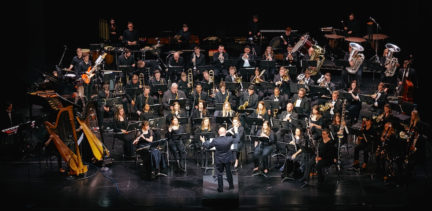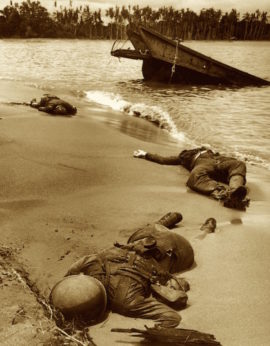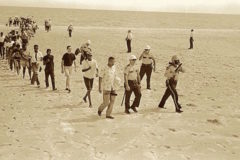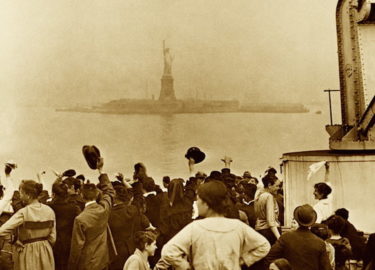This movement takes its inspiration from the image, Humanity Washed Ashore and the tragedy of those killed fleeing war in Syria. This image is of 3-year old Aylan Kurdi, but his 5-year old brother, Galip, and his mother, Rehan, also lost their lives when, in their attempt to flee as refugees, their boat capsized before reaching the Greek Island of Kos. In this movement, Freedom from Fear manifests itself in the Courage required to relinquish one’s homeland and extended family, while risking life in order to seek peace.
The movement takes its title from the Syrian folksong, Sleep, My Child, which is a folk song stemming from Aylan’s home of Aleppo. Some lyrics and brief melodic motives from a second Syrian folksong, Upon Thy Lovely Lips are also incorporated. I have ciphered the brothers’ names and the lyrics, Sleep, My Child into music pitches, which are used, along with elements of the folksongs, to create melodies, harmonies, and modes. A boy soprano sings in this movement as a representation of Aylan, and a soprano represents his mother, Rehan; a musical conversation occurs between mother and child. The lyrics of this lullaby speak to the tragedy of this image, not focusing specifically on the Syrian civil conflict since Aylan’s story transcends Syria’s present conflict and speaks to the Freedom from Fear facing all refugees.
Lullaby utilizes an abstraction of Syrian music by emulating Syrian instruments, the Qanun, Arghul, and Ney and the specific tunings associated with those instruments. The middle of this movement features an intense jazz-like feel that incorporates the rhythmic elements and variant forms of the Syrian Muwashshat – a musical form that, evolving from Arabic poetry, is popular in Aleppo where Aylan’s family originated.
lyrics
Sleep, my child, my pretty one, and softly dream.
Upon thy lovely lips I’ll dwell, and softly dream.
And there three years did you reign.
Peace, in Him, my pretty one, and softly dream.
Beneath His yoke thy soul shalt rest, and refuge seize.
Where forever more shalt thou reign.
I’d lose my soul without a pang, what do I care since thou art mine.
‘Twas not thy hand in Molech’s fire, consigned to flames, my soul’s desire.
Peace, in Him, my pretty one, and softly dream.
Beneath His yoke thy soul shalt rest, and refuge seize.
Where forever more shalt thou reign.
Sleep, Mother, my pretty one, and softly dream.
Upon thy lovely lips I’ll dwell, and softly dream.
Where forever more shalt thou reign.
4. Sea Crossings – Mother of Exiles
As a beacon of hope, the Statue of Liberty (Mother of Exiles) gives the displaced the Courage and Freedom from Fear to relinquish their homeland and start again, adopted by their new country. In this image, a ship, arriving in the New World, is filled with immigrants with Lady Liberty in the background. And, similar to Moses’ story of relinquishment and adoption in the first movement, and Aylan’s journey in the third movement, these displaced peoples leave their homeland, cross the seas, join millions of others displaced by fear, and seek refuge in a new, adopted homeland.
Portions of the sonnet, The New Colossus – penned by Emma Lazarus and inscribed on Lady Liberty’s pedestal, along with the words Mother of Exiles and Courage, are ciphered into pitches used for the entire movement. The Soprano soloist, representing Lady Liberty herself, intones those distinguishing words from the sonnet, summoning those from distant lands who would answer her call. The Courage motive, featured throughout the entire work and beginning with the entry of the Soprano here, permeates the second half of the symphony’s final movement and builds to a powerful conclusion by suggesting the arrival of new immigrants on Lady Liberty’s shoreline.
lyrics
Give me your tired, your poor,
Your huddled masses yearning to breathe free,
The wretched refuse of your teeming shore.
Send these, the homeless to me, your tempest-tost to me,
I lift my lamp beside the golden door!
All oppressed may enter here,
A refuge in times of trouble.
Be strong and courageous, and enlist preserving unity in the Spirit’s lease.
With Molech’s altars of fear vanquished, there will be peace.
I will be strong, I will show courage.
With Molech’s altars of fear vanquished, there will be peace.
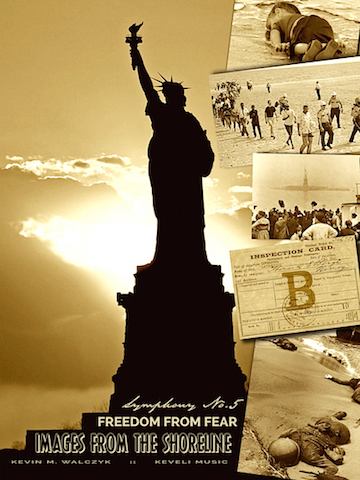
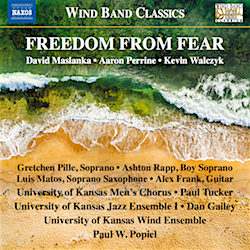 Symphony No. 5: Freedom From Fear - Images From The Shoreline was commissioned as the 2017-18 Legacy Project by Reach Out Kansas, Incorporated for the University of Kansas Wind Ensemble (Paul Popiel, director) and Jazz Ensemble I (Dan Gailey, director). The work pursues a programmatic idea that centers on displaced peoples and the global concept of Freedom from Fear - one of the Four Freedoms Franklin Delano Roosevelt spoke of in his 1941 United Nations inaugural address. FDR's Four Freedoms became so emblematic of the United Nations that they were added to its Universal Declaration of Human Rights. This Symphony is unified by the concept of Freedom from Fear as it impacts displaced peoples. Each movement is exemplified by an image connected to a shoreline (refer to the extended program notes below). The large work combines wind ensemble with jazz ensemble and features a Soprano soloist and Boy Soprano soloist. Symphony No. 5: Freedom From Fear - Images From The Shoreline received its premiere on April 18, 2018 with a repeat performance at the Kennedy Center for the Performing Arts in Washington DC on April 29, 2018.
Symphony No. 5: Freedom From Fear - Images From The Shoreline was commissioned as the 2017-18 Legacy Project by Reach Out Kansas, Incorporated for the University of Kansas Wind Ensemble (Paul Popiel, director) and Jazz Ensemble I (Dan Gailey, director). The work pursues a programmatic idea that centers on displaced peoples and the global concept of Freedom from Fear - one of the Four Freedoms Franklin Delano Roosevelt spoke of in his 1941 United Nations inaugural address. FDR's Four Freedoms became so emblematic of the United Nations that they were added to its Universal Declaration of Human Rights. This Symphony is unified by the concept of Freedom from Fear as it impacts displaced peoples. Each movement is exemplified by an image connected to a shoreline (refer to the extended program notes below). The large work combines wind ensemble with jazz ensemble and features a Soprano soloist and Boy Soprano soloist. Symphony No. 5: Freedom From Fear - Images From The Shoreline received its premiere on April 18, 2018 with a repeat performance at the Kennedy Center for the Performing Arts in Washington DC on April 29, 2018.
